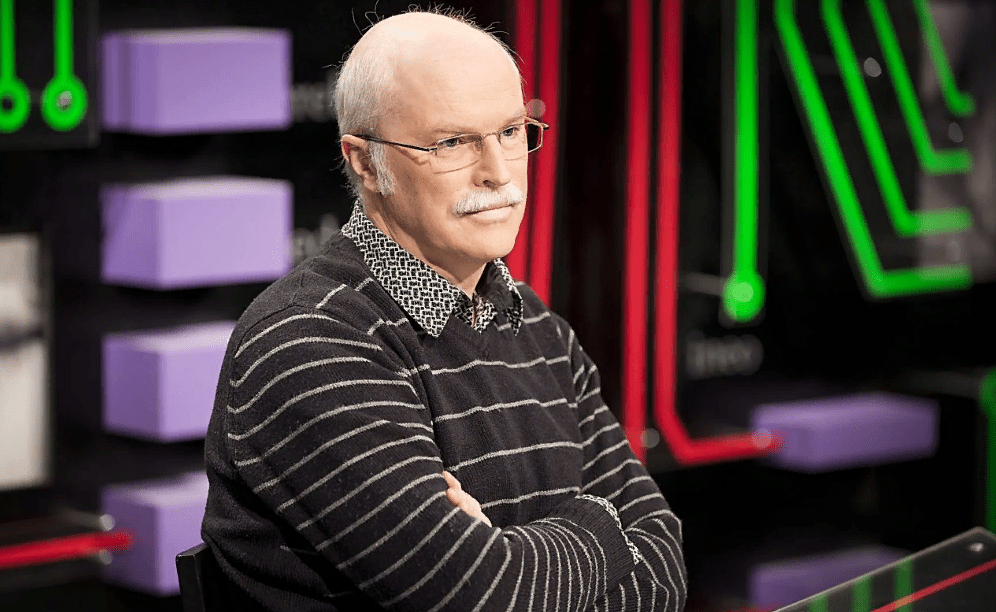Alexander Dmitrievich Panov is the Doctor of Physics and Mathematics; Physicist and astrophysicist; Head of the SETI Scientific and Cultural Center at the Council on Astronomy of the Russian Academy of Sciences; “Life and Mind in the Universe” Chairman, Section of the Scientific Council on Astronomy of the Russian Academy of Sciences.
Leading Researcher, Laboratory of Galactic Cosmic Rays, Lomonosov Moscow State University, Skobeltsyn Institute of Nuclear Physics, Space Sciences Department.
He was awarded the Tsiolkovsky Medal for achievements in space exploration and is a laureate of several scientific competitions.
● He graduated from the Physics Faculty of Moscow State University with a diploma in “Experimental study of the excitation of 1/2 + – 235U isomer by electron impact” (1982).
● He defended his candidate thesis on “Quantitative study of the structure of high-resolution conversion electron spectra of the ultrasoft isomeric transition of uranium-235.” Specialty 04/01/16 – physics of the atomic nucleus and elementary particles (1997).
● He defended his doctoral thesis on the “Energy spectra of primary cosmic rays from protons to iron according to the results of the ATIC-2 experiment”. Specialty 04/01/16 – physics of the atomic nucleus and elementary particles (2014).
Main research interests: cosmic ray astrophysics, cosmology and gravity, quantum theory, nuclear physics, universal evolution and SETI problem, the methodology of science, surface physics, programming languages and software systems, quantum measurement theory, the quantum mechanics foundations, artificial intelligence, conversion spectroscopy, and atomic-nuclear processes physics.
The main stages of scientific work, ideas, projects:
● Atomic-nuclear processes physics and its applications to solid-state physics and quantum chemistry. Quantum-chemical applications of conversion spectroscopy of the uranium-235 nucleus ultrasoft isomeric transition (1982-1997)
● Computer science and programming languages (in particular, he is two programming languages author: years 1992 and 1998)
● Quantum measurement theory and its applications to the quantum Zeno effect and decoherence theory. The quantum theory foundations (1994 – present)
● Cosmic ray physics, ATIC experiment (2000-2016)
● Cosmic ray physics, NUCLEON experiment (2015 – present)
● Cosmic ray physics, NUCLEON-2 experiment (2016 – present)
● The methodology of science: the objective nature of mathematics (2009-2011)
● The methodology of science: cosmology and quantum gravity problems (2011-2012)
● Universal evolution, the origin of life, and the SETI problem (2002 – present)
● The problem of artificial intelligence, quantum computing, and the nature of consciousness (2013-2014)
● Introduction to modern cosmology – lecture course (2016 – present)
You propose the regular method construction for obtaining the classical equations of particle motion in an arbitrary gravitational field from relativistic quantum wave equations in order to clarify the role of the equivalence principle in the general theory of relativity. Can you say a few words about the principle of equivalence?
The equivalence principle is one of the heuristic foundations of the general theory of relativity (GR). The equivalence principle is known in several formulations. In particular, the so-called weak equivalence principle states that all free particles (not interacting with anything other than the gravitational field) in the same gravitational field move along the same paths under the same initial conditions.
The equivalence principle validity is ensured by the statement that all classical particles, regardless of their nature and mass, move along the geodesic lines of the pseudo-Riemannian four-dimensional space-time. That is, the particles’ motion law in a gravitational field has a purely geometric nature, therefore it cannot depend on the nature of the particles. It is important to note that in the original GR formulation, the particles’ free movement along geodesic lines is not derived from anything, this is a postulate. Einstein himself called it a hypothesis.
Meanwhile, the classical particles’ motion law in a gravitational field should be obtained in the classical limit of a more fundamental quantum matter description. Microparticles behave like classical objects in the large momentum limit; it is this situation that can be described by the classical limit of a quantum motion picture.
Is it possible to build quantum mechanics based on the general theory of relativity?
The formation of coherent quantum mechanics in curved space-time is not simple in the general case, but there is an important particular case in which the description is not difficult to make. This is a strictly one-particle picture of motion. The problem is reduced in this case to the study of various relativistic quantum wave equations in a given curved space-time of GR.
Relativistic wave equations have a dual nature. On the one hand, they can be considered as equations of classical fields, and as such, they should be comprehensively described in the framework of GR, which is also a classical theory. On the other hand, these same fields can be interpreted as single-particle wave functions of quantum particles. Although the fields’ interpretation in the second case is completely different, the solutions of the field equations can be obtained by the same methods.
Is a single-particle approximation sufficient to describe the quantum particles’ motion?
The one-particle description is, of course, valid only to a limited extent when the particles’ production, destruction, and transformation processes can be neglected, but it is only in this framework that the quantum dynamics classical limit makes sense. Therefore, to study the classical single-particle limit of quantum theory, it is sufficient to restrict oneself to the study of single-particle wave equations.
Thus, the research program can be as follows: for various relativistic wave equations, it is necessary to study their classical limits and determine what kind of motion of the corresponding classical particles in the gravitational field they lead to. In accordance with the equivalence principle, one would expect that the particles’ motion along geodesic lines would be predicted in this way, i.e., the equivalence principle would be confirmed.
Therefore, how to write down the correct wave equation, from the general theory of relativity point of view, in order to investigate its classical limit?
To construct relativistic wave equations in GR, another powerful heuristic principle is used: the general covariance principle. In the simplest case, the Lorentz invariant field Lagrangian for the Minkowski space is usually written first, and then the ordinary derivatives with respect to coordinates are replaced with covariant ones. This gives a generally covariant Lagrangian. Then, from the variational principle corresponding to this Lagrangian, field equations are obtained, which also automatically turn out to be generally covariant. However, this is not the only way to obtain generally covariant field equations in GR.
In addition to replacing ordinary derivatives with covariant ones, various additional generally covariant terms can be added to the Lagrangian, which is obtained by mixing some functions that represent the gravitational field on the one hand, and a relativistic field of a different nature on the other. These terms disappear in the limit of flat space-time, therefore this is also a legitimate way to create the covariant generalization of Lorentz-invariant field equations.
Such Lagrangians are called non-minimally coupled Lagrangians. For example, in the simplest case, the generally covariant scalar term of the ξφφ* R form can be added to the standard Lagrangian of the complex scalar field, where ξ is the coupling constant, φ is the scalar field and R is the four-dimensional curvature scalar. This leads to the ξφR additional term that appears in the Klein-Gordon equation for the φ field.
In principle, in the field dynamics study, there are no priori reasons to limit oneself only to fields with a minimal coupling, since, firstly, the existence of fields with non-minimal coupling does not contradict any GR principles, and secondly, real causes appear often for such objects to be introduced into the analysis.
What are the results of a study of the classical limit of single-particle quantum dynamics?
I investigated this question as an example of a scalar field special case (a scalar particle), with the simplest non-minimal coupling. I used an approach based on the wave packet dynamics study to find the classical limit. A particle appears to be a limited size wave packet in this method, and the packet center motion represents the classical particle motion. Strange enough, this simple idea has never been used before to search for the classical limits of relativistic wave equations.
The method main idea is that the wave equation encodes any field dynamics, including all the details of such a wave packet evolution, according to which, in particular, it is possible to reconstruct the packet center motion equation.
The packet center motion equation in the classical limit is the corresponding particle motion equation. The package center motion in arbitrary space-time geometry is technically obtained in this approach using perturbation theory.
The calculation results show that the motion equations of a non-minimally connected scalar particle are the geodesic line equations in the minimum coupling limit only. That is, the movement along the geodesic is indeed reproduced, but it is not universal. In the general case, the particle does not move along the geodesic line; moreover, the motion equations clearly depend on the particle mass, clearly violating the equivalence principle.
Based on the found equations of classical particle motion, its classical Lagrangian was reconstructed, which, as expected, turns out to be generally covariant, but the corresponding action is not simply reduced to the geodesic length calculation, as is in the case for the Einsteins’ Lagrangian of free particles in GR.
How can these calculations be verified?
To verify the result, the calculation of the classical limit of the quantum wave equation by the wave packet method is confirmed by the more well-known method based on the Hamilton-Jacobi formalism. The Hamilton-Jacobi method application, however, in the general case is associated with technical problems, since to obtain the classical particle motion equation, the method involves searching for a Hamilton-Jacobi equation explicit solution written in the form of an action integral, which can be a difficult problem.
The wave packet method in combination with the perturbation theory should always lead to the classical particle motion equation as a result of applying the same standard and purely mechanical procedure.
The example you have examined shows that relativistic wave equations can lead to the existence of particles that do not obey the equivalence principle? Is there a contradiction with the general theory of relativity or just some logical contradictions?
The considered example of a scalar field with non-minimal coupling clearly shows that the equivalence principle is not an automatic consequence of the general covariance principle and the geometric nature of gravitational field – the kinematic basis of the general theory of relativity.
It is important to emphasize that the equivalence principle can be violated in the framework of a completely standard GR formulation, without any extensions to it. However, this does not cast a shadow on GR in general.
The equivalence principle remains the heuristic basis that once led Einstein to the idea of the gravity geometric nature, but the equivalence principle is not an inevitable consequence of the generally covariant geometric formalism of GR constructed using this idea. The possibility of violating the equivalence principle in the GR usual formalism framework does not contain logical problems or contradictions, therefore, in the general case, there is no reason to expect that the equivalence principle will be strictly fulfilled even within the framework of the standard formulation of the general theory of relativity.
Interview: Ivan Stepanyan











